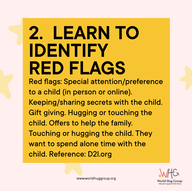|
Red Flags are warning signs indicating dangerous or manipulative behavior. These signs are not always easy to recognize, therefore we must remain aware and learn how to identify them. The Negative Grooming process looks like a normal behavior when it starts; the initial stages are full of attention, light conversations and care. The offender uses this to gain the child’s (and their caregiver's) trust and then uses this "trust" to gain access to the child and abuse him/her. |
It is important to remember that children and young people may not understand they are being groomed. They may have complicated feelings, like loyalty, admiration, love, as well as fear, distress, and confusion. The other adults and caregivers are also often unaware that they themselves are being groomed.
Abusers often groom friends, family, and others to overlook signs of abuse and cut ties with the victim. On the surface, grooming a child can look like a close relationship between the offending adult, the targeted child and the child's caregivers.
Here are some red flag behaviors to watch for:
- An adult targeting specific kids for special attention, activities, or gifts. Some offenders show preference for a particular gender, age, or “type.”
- Grooming starts with friendship to gain the trust of the kid and their caregiver. An adult spending a lot of time with a single child is a red flag. The Rule of Three is important. Always try to have at least two adults and one child present or one adult and two children present.
- Slowly isolating a kid from family members and friends: physically and emotionally. This could include finding reasons for isolated, one-on-one interactions (sleepovers, camping trips, day activities, etc.), or undermining relationships with parents and friends to show that “no one understands you like I do.”
- Gradually crossing physical boundaries.
- Gift giving to the child and/or the child's family.
- Encouraging a kid to keep secrets from family members. The shame and fear associated with child sexual abuse makes it easy for offenders to enforce secrecy in this area as well, keeping abuse “just between us.” https://www.d2l.org/child-grooming-signs-behavior-awareness/
The implementation and development of negative grooming tactics can take place over days, months and even years. It can be difficult to tell if a child is being negatively groomed – the signs are not always obvious and may be hidden.

